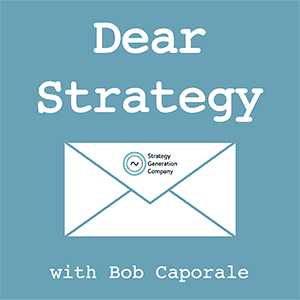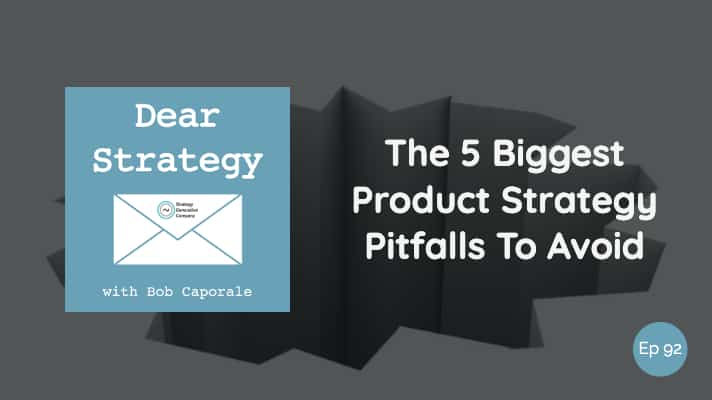Dear Strategy:
“What are some product strategy pitfalls to avoid?”
I’m happy to announce that my answer to this question will take the form of Dear Strategy’s very first listicle! So, without further ado, I present you with the 5 biggest product strategy pitfalls that every product manager should try to avoid:
Pitfall #1 – Not Having a Product Strategy
The first pitfall to avoid is, of course, having no strategy at all! Believe it or not, it is not very common (at least in my experience) for companies to adopt formal product strategy processes. I guess the thinking here is that product managers will have enough self-discipline to create their own strategies and then use those strategies to manage their product businesses. Great theory – but, in practice, every other aspect of the job (i.e. sales issues, pricing issues, quality issues, management requests, engineering questions, technical support, etc.) somehow seems to get in the way. And I’m not even talking about the technology space where, in some circles, a product strategy is looked upon as being some sort of “old school” requirement that will only serve to slow things down.
Needless to say, all of this can be avoided if companies would just adopt a formal product strategy process – requiring product managers to update their strategies to company leaders on at least an annual basis. But even if this isn’t the culture that your company chooses to adopt, you, as a product manager, will still need to have the discipline to create that product strategy process for yourself. And then you need to follow that process diligently every month, every quarter, and every year; regardless of whether your management requires it or not.
Pitfall #2 – Overanalyzing Your Current Situation
Assuming you do have some discipline around your product strategy process, the next pitfall to avoid is trying to be too exact when analyzing your current situation. This one is deeply rooted in never wanting to take any kind of a risk with your strategy. So, instead, you get caught up in the cycle of always collecting data and never really acting upon it, because you’re just not confident that it’s ever going to be accurate enough.
I’m here to tell you that, despite how many times your leaders may have scolded you to the contrary, trying to dot every ‘i’ and cross every ‘t’ is a recipe for strategic disaster. By its very nature, strategic planning is about trying to predict the future. And no matter how much data you have, there’s no way that you’ll ever be able to predict the future with 100% accuracy. So does that mean you should base your strategy on gut instinct alone? Although that approach has certainly worked for more than a fair share of successful companies, the truth is that the less data you use as a basis for your strategy, the riskier your assumptions (and, therefore, your strategy) will ultimately be. However, on the other side of that equation, the more data you use, the greater your chances of putting together a strategy that is largely going to be “safe” – or, worse, the same as everyone else’s. The goal, then, will be to find that sweet spot mix of data and intuition, which should represent just the right amount of analysis to help move you forward without ever really holding you back.
“…despite how many times your leaders may have scolded you to the contrary, trying to dot every ‘i’ and cross every ‘t’ is a recipe for strategic disaster.”
Pitfall #3 – Assuming That Your Strategy Will Be Free
We’ve all heard that most strategies fail in their execution. And although it’s hard to disagree with that statement, I think it’s far more productive to try and understand exactly why that is. And here’s what I’ve come up with: In my observation, it seems like many strategies tend to stop at the high-level flowery statements about the major strategic initiatives that a company plans to focus on. Now, don’t get me wrong, I have nothing against those flowery statements since I teach people how to write them all the time. I do, however, have a problem when companies believe that their strategic plans both begin and end with those statements, because that’s when things really start to go off the rails.
The truth is that those high-level strategic initiatives have to be supported by some level of real investment that will inevitably be required to make those statements come true. Unfortunately, that part of the equation is all too easy for company leaders to ignore; instead opting to point at their teams with their magical wands of intimidation while reciting that ever-so-popular management incantation of “just make it happen!” And to that I say, “no” – because nothing happens for free. And any company that thinks they can just will their way to success without investing some amount of extra time, money, or resources, is just setting themselves up for failure. Blame who you will – but strategies require investments to bring them to life. And if you don’t account for that investment in your plan, your strategy will fail. Full stop.
Pitfall #4 – Presenting the Strategy You Think Your Leaders Want to Hear
Our fourth pitfall is another one of those dynamics that are deeply rooted in the flaws of our own human psyche. We all want to be liked; we all want to be accepted; we all want to fit in. And, because of that, we are not always inclined to tell each other what we really think – opting instead to tell each other what we think the other person wants to hear. The trouble is, when you apply that little quirk into a business arena, what you get are a bunch of unchecked emperors who never get told when they don’t have any clothes on.
In fact, the best leaders already know that their blind spots become exponentially larger as their leadership responsibilities expand. And, because of that, those leaders actually want their teams to be honest with them – particular during the strategic process. Now, I’m not saying that every leader is going to fall into this category; so, I realize that many of you may need to proceed with caution around this particular pitfall. But, in general, my experience is that most leaders want only one thing from their product managers – the truth. For you, that means doing your homework, putting together your plan, and being confident in your approach – even if your strategy doesn’t meet with the 100% approval of your leaders (because, by the way, it never will). So, don’t tell your leaders what you think they want to hear, because what they really want to hear is what you actually want to do.
Pitfall #5 – Not Socializing Your Strategy
The fifth and final pitfall to avoid may be the easiest one on our list. That is, you have to avoid the trap of not fully communicating your strategy to everyone that needs to know about it. Assuming you do have a formal product strategy process in place within your company, it’s going to be easy to communicate your strategy to that small handful of leaders who have actually asked to see it. But, aside from giving you the green light to proceed, these are not the people who are actually going to help you bring your strategy to life.
Instead, you need to make sure you’re talking to all the supporting teams, departments, and individuals that will ultimately be needed to help you carry out your plan. You need to make sure they’re all fully informed about what you intend to do, how you intend to do it, and what exactly you need them to do in the process. That means you need to take that same presentation you gave to your company leaders (or some version thereof) and take it on the road. Present it to your Sales, Marketing, Manufacturing, and Sales teams. Communicate it to your support functions, your channel partners, and maybe even some of your customers. This is the part of the process that’s far too easy to overlook, because we all tend to breathe a sigh of relief once we “get through” that overly-stressful presentation to our leadership teams. But, in reality, that presentation should be the easy part. If you really want your strategy to succeed, you need to get the buy-in of everyone else that matters. And, perhaps overwhelmingly so, that happens to be just about everyone else you know.
So, that’s pretty much it – my very first Dear Strategy listicle! I truly hope it’s been helpful. And if you liked this format, please drop us a line or leave a comment below and be sure to let me know. I can’t promise that this format is going to become a regular “thing,” but I can promise that I’ll incorporate your feedback into my next Dear Strategy strategy!
Listen to the podcast episode
Dear Strategy: Episode 092

###
Are you interested in strategy workshops for your product, marketing, or business managers? If so, please be sure to visit Strategy Generation Company by clicking the link below:
 Bob Caporale is the founder of Strategy Generation Company, the author of Creative Strategy Generation and the host of the Dear Strategy podcast. You can learn more about his work by visiting bobcaporale.com.
Bob Caporale is the founder of Strategy Generation Company, the author of Creative Strategy Generation and the host of the Dear Strategy podcast. You can learn more about his work by visiting bobcaporale.com.









Love the advice… agree with all 5 points. I might add connecting the strategy with an investment plan is also critical; not all strategies I’ve seen talk about execution, and investment is a key part of this. Connecting the investment plan to the company resource allocation (annual financial plan) process is important as well.